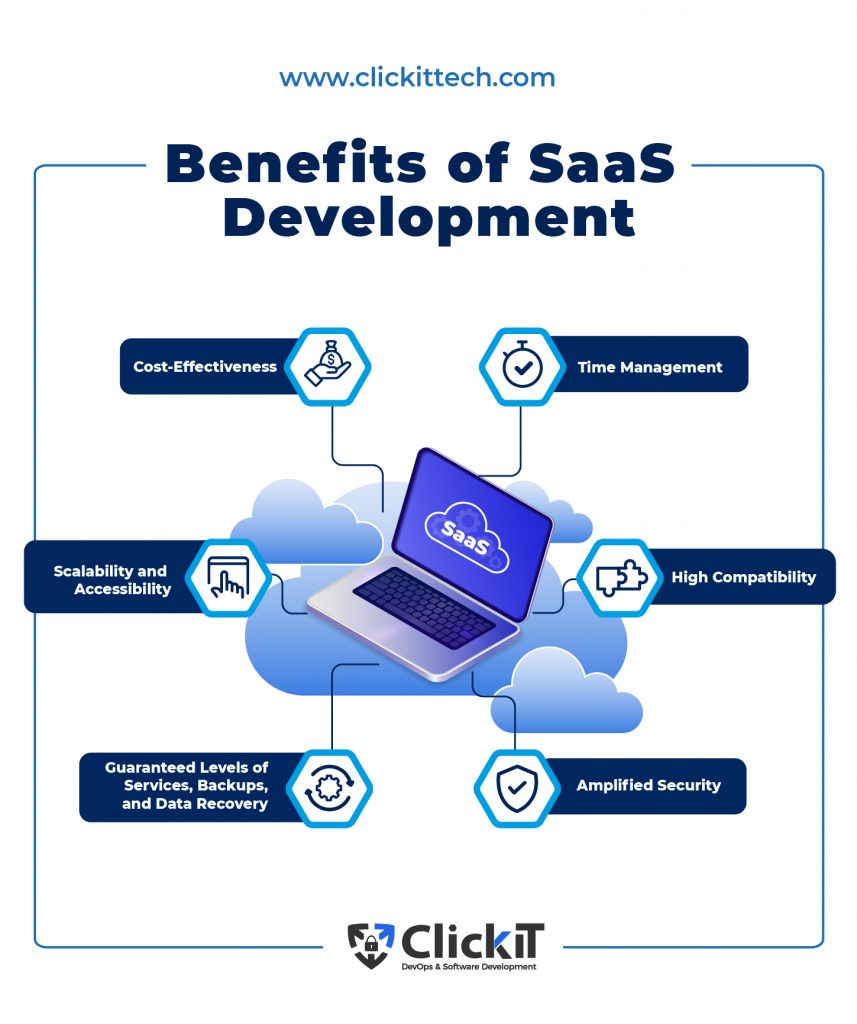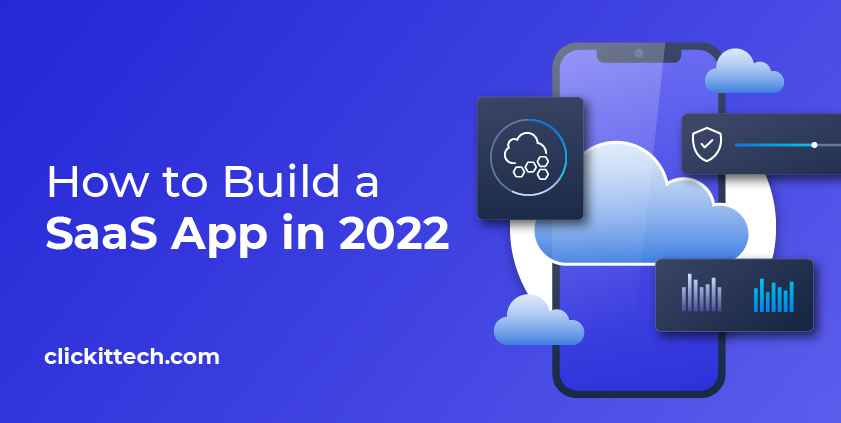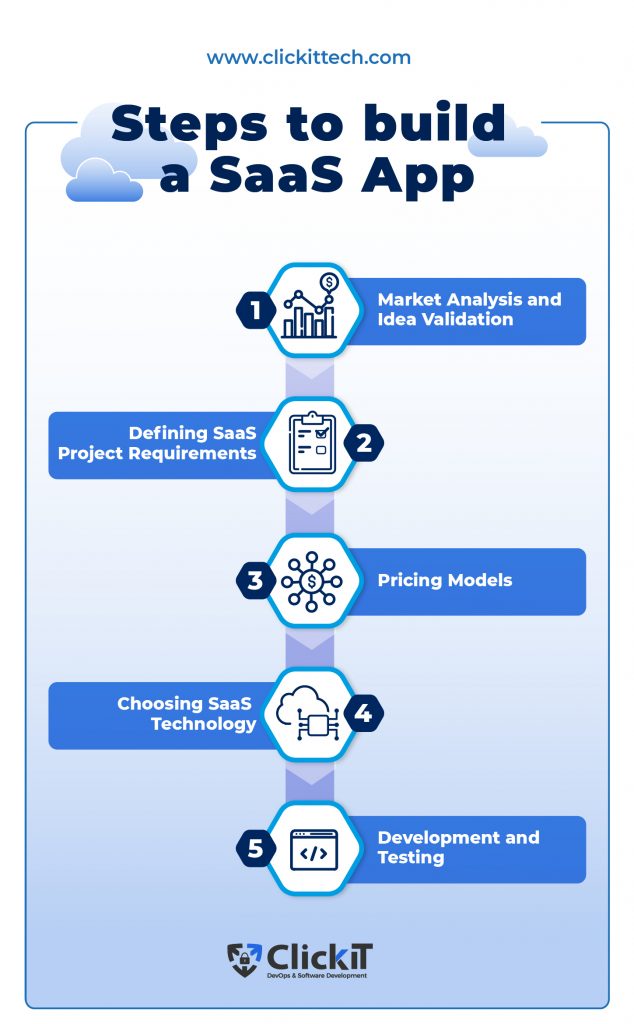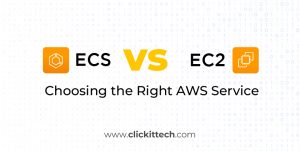SaaS, also known as Software as a Service, is a method of delivering applications through the internet as a form of service. Rather than using the old methods requiring installation and maintaining the software, SaaS allows you to access the software through the Internet easily. SaaS development provides freedom from highly complex software and having to manage hardware. SaaS applications are also referred to as Web-based, on-demand, or hosted software.
Regardless of the name used to describe it, all SaaS applications operate on a SaaS provider server. The provider server manages access to the applications, including security, availability and performance.
With SaaS, a cloud provider is used to distribute the software, making the software available to users through the Internet. With this SaaS software development distribution model, an independent software vendor (ISV) can send a contract to a third-party cloud provider offering the application. When it comes to big corporations such as Microsoft, the cloud provider can also potentially be the software vendor. With SaaS, there is no need to install desktop applications. Instead, users can simply subscribe to the service available on a remote server.
Table of contents
- Choose your Industry for your SaaS Development
- Types of SaaS Apps you can Develop
- SaaS Development Steps
- Benefits of SaaS Development
- Conclusion of SaaS Development
- SaaS Development FAQs
Choose your Industry for your SaaS Development
The application of SaaS development cuts across diverse industries. Therefore, you need to have a target industry for your SaaS dev project. You will find potential industries worth exploring below!
SaaS Development Industry: FinTech
SaaS Development is useful in the FinTech industry and assists companies with remaining ahead of the curve. SaaS development applications have reduced infrastructure costs and provided several benefits to previously unavailable banks, telecommunications companies, insurance companies, and other payment businesses. These benefits include cost savings, data security, scalability, and agility. By nature, SaaS systems are constantly updated, resulting in companies in the FinTech industry using the latest technological devices.
The presence of SaaS development in the FinTech industry makes it easy to include new clients to a company’s framework. SaaS applications provide agility to FinTech companies, securing existing revenue streams and helping the companies seize new market opportunities. SaaS development services in the FinTech industry is also highly beneficial because of the fact that it’s cost-effective, adds value, and removes the need for repetitive work. Furthermore, SaaS offers cost-effective scalability and is constantly updated. It comes with high and automated security and controls, makes it easy to analyze data for business growth and backs up the data required for business continuity.
Read our blog about the top SaaS security best practices.
SaaS Development Industry: ML & AI
AI and ML with a SaaS development component can help improve customer experience and internal collaboration and increase revenue. ML makes predicting customer behaviors, identifying patterns and auto-segmenting customers easier. AL and MI can also be helpful when it comes to reducing the time spent on reporting.
SaaS development in AI & ML results in a personalized experience as the preferences and behaviors of each user are observed and studied. It’s, therefore, easier to provide actionable insights and help configure the user interfaces when required— thus creating an AI or Machine Learning-based solution as a SaaS application and making it accessible, scalable, and easier to monetize.
Partner with ClickIT for Top SaaS Development services in any industry.
SaaS Development Industry: IoT and Wearable Technology
Wearable technology consists of devices that can be worn on the body as accessories. They can also be implanted in the user’s body or embedded into the clothing as part of the textiles. These days, smartwatches, fitness trackers and smart glasses are the most popular wearable devices. Wearable technologies and IoT are incredibly useful for obtaining large data and user information.
The infusion of SaaS into IoT and wearable technology makes it much easier to streamline information and gather invaluable data that can help improve efficiency and forecast the future. IoT SaaS providers offer several features, including scalability, real-time data capture and machine learning. SaaS development can easily double or even triple the adoption rate of IoT and wearable devices. In turn, this eliminates the need to invest in low-tech components which require desktop data integration and sharing support.
SaaS Development Industry: Healthcare
SaaS applications are critical in the healthcare industry. They help provide a superior patient experience and make the job of healthcare professionals much easier. In a nutshell, SaaS development services in the healthcare industry offers real-time updates and accessibility and is incredibly cost-effective. SaaS helps reduce costs, improve care quality, and avoid inefficient hospital management. It drastically reduces coordination issues between multiple health providers, thus improving the patient’s overall health experience.

What are the Types of SaaS Applications you can Develop?
The beauty of SaaS is that it covers all industries and reaches various markets. In other words, SaaS has a vast and diverse market. It’s, therefore, no surprise that SaaS is a prosperous technology that has generated billions of dollars for multiple SaaS development services and companies on the market today.
Seeing as SaaS is a highly segmented market, both large and small businesses can find their niche and flourish within it. Some types of SaaS development include:
CRM Solutions
Customer Relationship Management (CRM) software services provide a center that deals extensively with customer-related operations. It’s an essential tool that helps drive business success. CRM Solutions help assemble, categorize and analyze customer data from various channels. These numerous channels include, but are not limited to, phone calls, social media and website activity. CRM Solutions aim to provide premium customer engagement tools such as loyalty campaigns and email marketing to companies that need them.
The provision of high-end customer engagement tools helps boost sales and foster conversations between brands and their clients. The result is improved customer relationships, customer segmentation and better privacy protection. The most common users of CRM solutions are B2C companies (companies that sell directly to consumers). CRM Solutions are also widely used within sales, marketing, and customer service teams. With CRM SaaS software, the users can automate repetitive tasks, create sales reports, and forecast and scale processes over time. This SaaS software development service also helps manage customer communication and data in a centralized database.
Accounting Solutions
The accounting solution platforms render much-needed assistance to accountants and bookkeepers in areas where they need it most. Other industries which greatly benefit from this SaaS application include business services, manufacturing, retail and the government. This application is beneficial for every business, as keeping records of money movement is essential for the survival of any business. Accounting SaaS software development helps simplify document flow by providing customizable templates.
In addition, the accounting solution SaaS applications also help manage orders, revenue, billing, inventory, fixed assets and taxes.
The SaaS development service in this category offers data-based revelations that significantly improve the quality of financial decisions. The carefully designed SaaS development applications integrate popular SaaS accounting systems and automate the budgeting workflows, thus generating simple and accurate analytics. A SaaS application developed for managing the finances of a company or business definitely helps save a lot of time and effort. Let’s be honest, time spent reconciling accounts, correcting financial errors, inputting data entry, payroll, taxes and customer payments are always better spent doing something else.
Project Management Solutions
Project management SaaS dev tools are essential for businesses that aim for efficient project delivery. They help boost cooperation and ensure efficient tracking within teams. Most businesses are often in between projects or running several projects simultaneously across several groups. Therefore, everyone must be in sync to ensure the smooth running of the project. Using project management systems helps break down the projects into smaller bite-sized tasks and provides the ability to plan, track, allocate, schedule, communicate and collaborate with members of the same team, or even different teams, on projects that span across multiple groups.
SaaS development applications also help define the project milestones, assign tasks to the appropriate team members and create project deadlines. Many project management solutions help bring the data to life through Gantt charts and Kanban boards and also help whip up productivity reports. Project management SaaS Development services make it easy to see the project develop in real-time. These solutions also show who has completed their work section to enable the team to move on to the next project phase.
E-commerce Solutions
Another SaaS development service, are E-commerce platforms perfectly implement out-of-the-box features, which are highly helpful for online sales. They are also an excellent option for new businesses wishing to start immediately. E-commerce SaaS development solutions make it easy for anyone to create and set up their online store within minutes. There is no need for a degree or a class. With E-commerce solutions, developing a website isn’t necessary to set up an online store.
The platforms make it easy to add and remove products, manage inventories, calculate taxes, integrate the payment systems and create blogs and market campaigns. A lot of the e-commerce solutions available on the market today can also support design customization. Users can set themselves apart by creating a unique online presence that reflects their brand identity. This particular category of SaaS development services allows for building storefronts for multiple vendors.
SaaS Development Steps
As SaaS applications are critical in several industries, it should be no surprise that numerous SaaS applications are currently available on the market. SaaS software development comes with specific peculiarities, thanks to its cloud-based nature. The steps to take when building a SaaS app from scratch include:
1. Market Analysis and Idea Validation
Like any other invention, developing SaaS application begins with an idea. Coming up with an idea and validating the concept by conducting in-depth market research are the first steps that must be taken when developing a SaaS app.
Before building a SaaS app, it’s essential to pinpoint the value the project will bring to users. The app must meet certain of the client’s needs which, in turn, will encourage them to pay for it regularly. Before pulling out the toolbox to build your SaaS app, you must identify and extensively study your target audience. What a SaaS application does will help refine and fine-tune the SaaS app into something worth having.
Understanding your competitors’ weaknesses will also help you create a unique SaaS app that sets you apart from the competition.
2. Defining SaaS Project Requirements
The requirements include features, functionality, usability, additional security risks and potential reliability issues. When building a SaaS app, these requirements must be considered and implemented to ensure the app’s usability and sustainability. The developer must also carefully consider the structured architecture of the app. The developer can create the SaaS software development as a single-page, multi-page, multi-tenant or single tenant. Each option has pros and cons, affecting the type of SaaS app developed. SaaS apps differ from traditional apps seeing as SaaS runs in the cloud.
In light of the above, to develop a SaaS app, you need a reliable cloud vendor. Your development team must also consider the multi-tenancy issue. Several users accessing an app simultaneously create specific demands on the SaaS app architecture. Therefore, optimal system architecture must be in place for the SaaS app to endure all of the data being encrypted and backed up.
The web app design’s user interface (UI) and user experience (UX) are also critical and must be carefully considered. The interface must be meticulously designed to meet the target audience’s needs. SaaS applications should be able to work on both computers and mobile devices. Furthermore, UI/UX designs must be compatible with different resolutions to suit the office and home on the go.
Build a SaaS application from scratch with ClickIT. Contact us
3. Pricing Models
In order to build and sustain a successful SaaS app, figuring out the right pricing strategy is vital. There needs to be a balance when choosing a suitable price range. The optimal price range offers a return on investment, all while being a reasonable price for users to pay. Most SaaS products make use of either subscription or freemium models. A subscription model offers different subscription plans with specific features included with specific subscription models.
With the freemium model, users can utilize basic features for free but need to pay to access the advanced features. The basic features attract the users and allow them to get used to the app. Once they are accustomed to the services available on the platform, they will usually be more inclined to pay for premium features. Other payment models available include flat rates, pay-per-user, pay-per-feature, usage-based pricing models, transaction fees, selling fees and in-app advertising.
Read our blog, Top 6 SaaS Business Models.
4. Choosing SaaS Technology
Another critical aspect of developing a SaaS app is choosing the right tech stack. SaaS requires client-side (front-end), server-side, and database development. The back-end and cloud server deployment must also be considered. Luckily, several frameworks and tools can be chosen when building a SaaS app.
Selecting the right tech stack for the features you want on your SaaS app is essential. An important aspect to consider when choosing the tech stack is the scale of the app, the maturity of its technology and its integration with third-party systems.
5. Development and Testing
Testing the SaaS application is necessary to work out any issues and ensure the app is perfect and ready for general use. A SaaS application is not built in the blink of an eye. Indeed, creating a SaaS application starts with considering a minimum viable product (MVP). The MVP only includes the application’s essential features, which meet the target audience’s basic needs. The MVP receives feedback from first adopters, which helps provide a springboard for adjustments, corrections, and improvements.
What are the Benefits of SaaS Development?
SaaS development advantages businesses and companies in many ways. Some of the benefits of SaaS development services include:

Cost-Effectiveness
SaaS can be incredibly cost-effective and result in savings for several reasons. With SaaS applications, there is no need for purchase and installation payment. Ongoing costs related to things such as maintenance and upgrades are also eliminated. In most cases, the amount budgeted for hardware resources can go towards other areas. The pay-as-you-go SaaS pricing model allows businesses to reduce costs seeing as they only have to pay for the software. Finally, it eliminates fees wasted on unused licensing.
Time Management
SaaS developments can be very time-effective as well. With SaaS applications, installation only requires an internet connection and a log-in password. With SaaS applications, maintenance responsibilities do not fall upon the users but are rather automatically upgraded. This eliminates the extra downtime spent on upgrading standard softwares.
Scalability and Accessibility
SaaS development services offers excellent flexibility. Seeing as SaaS applications are hosted externally by the application development company, businesses can change their usage plan without worrying about giving any advance notice. Furthermore, anyone from anywhere in the world can access the SaaS application anytime. The ease and accessibility of SaaS applications make work effective and allow access to data from anywhere.
High Compatibility
For standard software installation, updates are incredibly time-consuming and expensive. To make things worse, various compatibility issues these days make the upgrading process even more frustrating.
All of this can be avoided with SaaS dev. The user simply needs to log on to the latest upgraded version of the SaaS software development. The onus of managing updates and upgrades is on the vendor, which must ensure that the end-user has the most up-to-date version for use. A fundamental tenet of SaaS is that it eliminates software maintenance and incompatibility problems. Therefore, the business is provided with a streamlined focus and higher productivity.
Guaranteed Levels of Services, Backups, and Data Recovery
A major difference between SaaS and traditional software development is that SaaS applications provide precise detail on how the software works. It’s well-known that standard software requires a time-consuming and labor-intensive backup process. This extremely tiring work is often done weekly and can only be circumvented if an expensive automated solution is deployed.
SaaS development applications eliminate the laborious process required to backup data. Instead, the backups are done automatically without user intervention. This helps maintain the integrity of the data.
Amplified Security
For the most part, SaaS developments protect organizations’ information better than traditional software development. Over time, SaaS applications have come a long way. These days, they offer a highly safe and secure platform that allows organizations to store their valuable business data efficiently. SaaS development applications, platforms, servers, and data are proactively protected and managed by several data security specialists. This provides incredible peace of mind for organizations, as data safety and security are assured.

Conclusion of SaaS Development
Building a great SaaS application requires time, dedication, and technical know-how. In light of the various complexities involved, working with a team that understands what constitutes a good SaaS application is often a great idea. The team should appreciate your opinion and understand your vision for things to run smoothly.
The features you want on your SaaS application determine the number and roles of developers you need to build your team. Before heading into the development phase, you should speak with a SaaS software development agency that understands the intricacies of developing a SaaS application. This way, you can create an outstanding team that can address all of the essential features of your app.
If you are looking to develop a SaaS application, ClickIT is the best DevOps team to assist you with top SaaS development services . We help build high-quality applications that suit the needs and desires of our clients to the T.
SaaS Development FAQs
It takes about three to nine months to develop a SaaS application. The time varies depending on factors such as complexity, features to be included, and the number of stages required before launching.
Software as a service, SaaS, is a complete application that offers software solutions from a cloud service provider. It allows users to connect to and use cloud-based apps over the Internet.
Yes. A solo developer can definitely build a profitable SaaS app alone. That said, in order to do so, the developer must have an adequate understanding of what it takes to build a SaaS application.
Starting a SaaS company is not an easy venture. It requires a lot of time, focus, and effort and involves building the right team of people who buy into the idea and are willing to work together to make the dream a reality.
Building a SaaS application requires a great idea, hard work, a practical approach, forward-thinking, technical know-how, execution skills and excellent organization.









